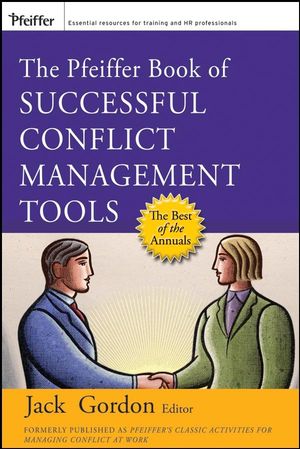The Pfeiffer Book of Successful Conflict Management ToolsISBN: 978-0-470-19344-0
Paperback
452 pages
October 2007, Pfeiffer
 |
||||||
About the Editor.
Introduction.
PART 1: PRESENTATION AND DISCUSSION RESOURCES.
1. The Art of Creative Fighting (H.B. Karp).
2. Conflict-Resolution Strategies (Joan A. Stepsis).
3. Win/Lose Situations (Gerry E. Wiley).
4. A Taxonomy of Intergroup Conflict-Resolution Strategies (Daniel C. Feldman).
5. Developing Collaboration in Organizations (Udai Pareek).
6. Constructive Conflict in Discussions: Learning to Manage Disagreements Effectively (Julia T. Wood).
7. Dealing with Disruptive People in Meetings (John E. Jones).
8. Confrontational Communication (Merna L. Skinner).
9. A Positive Approach to Resistance (H.B. Karp).
10. Breaking Down Boundaries: Breaking Through Resistance (Ron Ashkenas).
PART 2: EXPERIENTIAL LEARNING ACTIVITIES.
Experiential Learning Activities: Conflict and the Team .
1. What to Look for in Groups: An Observation Guide (Philip G. Hanson).
2. Conflict Styles: Organizational Decision Making (Donald T. Simpson).
3. Win As Much As You Can: An Intergroup Competition (W. Gellerman).
4. Power Poker: What’s in It for Me? (Linda Raudenbush and Steve Sugar).
5. Trouble in Manufacturing: Managing Interpersonal Conflict (John E. Oliver).
6. Dynasell: Hidden Agendas and Trust (William W. Kibler).
7. Current Status: A Feedback Activity on Trust (Robert N. Glenn).
Experiential Learning Activities: Conflict and the Individual.
8. Retaliatory Cycle: Introducing the Elements of Conflict (Daniel Dana).
9. Alter Ego: Saying What You Mean (Duane C. Tway).
10. Conflict Role Play: Resolving Differences (Robert P. Belforti, Lauren A. Hagan, Ben Markens, Cheryl A. Monyak, Gary N. Powell, Karen Sykas Sighinolfi).
11. Resistance: A Role Play (H.B. Karp).
12. Neutral Corner: Deciding on an Issue (Linda Raudenbush and Steve Sugar).
13. Communication Games: Eliminating Unproductive (Don Morrison).
14. The Company Task Force: Dealing with Disruptive Behavior (Suzanne W. Whitcomb).
Experiential Learning Activities: Conflict and the Organization.
15. Budget Cutting: Conflict and Consensus Seeking (Terry L. Maris).
16. Winterset High School: An Intergroup-Conflict Simulation (Charles E. List).
17. Crime-Fighting Task Force: Understanding Political Tactics in Groups (R. Bruce McAfee and Robert A. Herring III).
18. Piccadilly Manor: Improving Decision Making in a Political Milieu (A. Carol Rusaw).
19. Merger Mania: Understanding Intercultural Negotiation (John Chesser).
20. Lindell-Billings Corporation: A Confrontational Role Play (Thomas H. Patten, Jr).
PART 3: INVENTORIES, QUESTIONNAIRES, AND SURVEYS.
1. Conflict Management Climate Index (Bob Crosby and John J. Scherer).
2. Cornerstones: A Measure of Trust in Work Relationships (Amy M. Birtel, Valerie C. Nellen, and Susan B. Wilkes).
3. The Team Effectiveness Critique (Mark Alexander).
4. Trust-Orientation Profile (Myron R. Chartier).
5. Conflict-Management Style Survey (Marc Robert).
6. Communication Audit: A Pairs Analysis (Scott B. Parry).
7. Inventory of Anger Communication (IAC) (Millard J. Bienvenu, Sr.).
8. The Defensiveness Inventory (Beverly Byrum-Robinson and B.J. Hennig).



